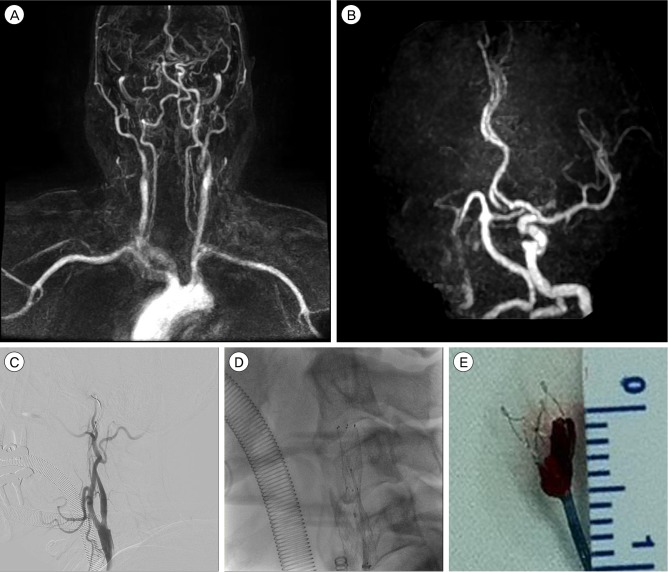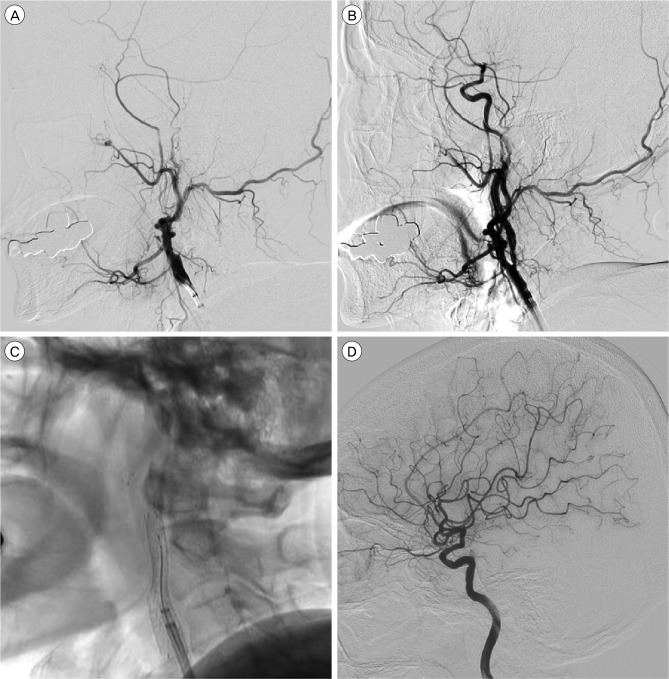J Cerebrovasc Endovasc Neurosurg.
2017 Sep;19(3):207-212. 10.7461/jcen.2017.19.3.207.
How to Escape Stentriever Wedging in an Open-cell Carotid Stent during Mechanical Thrombectomy for Tandem Cervical Internal Carotid Artery and Middle Cerebral Artery Occlusion
- Affiliations
-
- 1Department of Neurosurgery, Guro Hospital, Korea University, Seoul, Korea. ywk0013@gmail.com
- KMID: 2393504
- DOI: http://doi.org/10.7461/jcen.2017.19.3.207
Abstract
- We present 2 cases of complicated mechanical thrombectomy involving tandem cervical internal carotid artery and middle cerebral artery occlusion using the Solitaire FR stent and simultaneous carotid stent angioplasty. During the procedures, the Solitaire stents containing the thrombus were wedged into the open-cell carotid stents, which were already deployed for proximal flow restoration. We describe the methods used to avoid and overcome such complications.
MeSH Terms
Figure
Reference
-
1. Akpinar CK, Gurkas E, Aytac E. Carotid angioplasty-assisted mechanical thrombectomy without urgent stenting may be a better option in acute tandem occlusions. Interv Neuroradiol. 2017; 8. 23(4):405–411. PMID: 28504557.
Article2. Behme D, Knauth M, Psychogios MN. Retriever wire supported carotid artery revascularization (ReWiSed CARe) in acute ischemic stroke with underlying tandem occlusion caused by an internal carotid artery dissection: Technical note. Interv Neuroradiol. 2017; 6. 23(3):289–292. PMID: 28162027.
Article3. Castano C, Dorado L, Guerrero C, Millan M, Gomis M, Perez de la Ossa N, et al. Mechanical thrombectomy with the Solitaire AB device in large artery occlusions of the anterior circulation: a pilot study. Stroke. 2010; 8. 41(8):1836–1840. PMID: 20538693.4. Cobb MIH, Smith TP, Brown PA, Gonzalez LF, Zomorodi AR. Carotid Endarterectomy to Remove Retained Solitaire Stent Retriever inside Carotid Stent after Mechanical Thrombectomy. J Stroke Cerebrovasc Dis. 2017; 5. 26(5):e90–e95. PMID: 28318956.
Article5. Cohen JE, Gomori JM, Rajz G, Itshayek E, Eichel R, Leker RR. Extracranial carotid artery stenting followed by intracranial stent-based thrombectomy for acute tandem occlusive disease. J Neurointerv Surg. 2015; 6. 7(6):412–417. PMID: 24727131.
Article6. Cohen JE, Gomori M, Rajz G, Moscovici S, Leker RR, Rosenberg S, et al. Emergent stent-assisted angioplasty of extracranial internal carotid artery and intracranial stent-based thrombectomy in acute tandem occlusive disease: technical considerations. J Neurointerv Surg. 2013; 9. 5(5):440–446. PMID: 22753268.
Article7. Forlivesi S, Pancheri E, Moretto G, Bovi P, Cappellari M. Early secondary prevention after initially ineffective revascularization treatments for acute ischemic stroke due to tandem occlusion. Blood Coagul Fibrinolysis. 2017; 9. 28(6):493–495. PMID: 28319471.
Article8. Grigoryan M, Haussen DC, Hassan AE, Lima A, Grossberg J, Rebello LC, et al. Endovascular treatment of acute ischemic stroke due to tandem occlusions: large multicenter series and systematic review. Cerebrovasc Dis. 2016; 12. 41(5-6):306–312. PMID: 26881779.
Article9. Hui FK, Hussain MS, Elgabaly MH, Sivapatham T, Katzan IL, Spiotta AM. Embolic protection devices and the Penumbra 054 catheter: utility in tandem occlusions in acute ischemic stroke. J Neurointerv Surg. 2011; 3. 3(1):50–53. PMID: 21990789.
Article10. Jankowitz B, Grandhi R, Horev A, Aghaebrahim A, Jadhav A, Linares G, et al. Primary manual aspiration thrombectomy (MAT) for acute ischemic stroke: safety, feasibility and outcomes in 112 consecutive patients. J Neurointerv Surg. 2015; 1. 7(1):27–31. PMID: 24385557.11. Lockau H, Liebig T, Henning T, Neuschmelting V, Stetefeld H, Kabbasch C, et al. Mechanical thrombectomy in tandem occlusion: procedural considerations and clinical results. Neuroradiology. 2015; 6. 57(6):589–598. PMID: 25404414.
Article12. Mbabuike N, Gassie K, Brown B, Miller DA, Tawk RG. Revascularization of tandem occlusions in acute ischemic stroke: review of the literature and illustrative case. Neurosurg Focus. 2017; 4. 42(4):E15.
Article13. Miteff F, Faulder KC, Goh AC, Steinfort BS, Sue C, Harrington TJ. Mechanical thrombectomy with a self-expanding retrievable intracranial stent (Solitaire AB): experience in 26 patients with acute cerebral artery occlusion. AJNR Am J Neuroradiol. 2011; Jun-Jul. 32(6):1078–1081. PMID: 21493763.14. Mpotsaris A, Bussmeyer M, Buchner H, Weber W. Clinical outcome of neurointerventional emergency treatment of extra- or intracranial tandem occlusions in acute major stroke: antegrade approach with wallstent and solitaire stent retriever. Clin Neuroradiol. 2013; 9. 23(3):207–215. PMID: 23354342.
Article15. Mpotsaris A, Bussmeyer M, Loehr C, Oelerich M, Buchner H, Weber W. Mechanical thrombectomy in severe acute stroke: preliminary results of the Solitaire stent. J Neurol Neurosurg Psychiatry. 2012; 1. 83(1):117–118. PMID: 21212105.16. Muller-Hulsbeck S, Schafer PJ, Charalambous N, Schaffner SR, Heller M, Jahnke T. Comparison of carotid stents: an in-vitro experiment focusing on stent design. J Endovasc Ther. 2009; 4. 16(2):168–177. PMID: 19456191.17. Padalino DJ, Deshaies EM. Tandem middle cerebral artery-internal carotid artery occlusions: reduced occlusion-to-revascularization time using a trans-anterior communicating artery approach with a penumbra device. J Neurosurg. 2012; 3. 116(3):665–671. PMID: 22196094.
Article18. Perez MA, Miloslavski E, Fischer S, Bazner H, Henkes H. Intracranial thrombectomy using the Solitaire stent: a historical vignette. J Neurointerv Surg. 2012; 11. 4(6):e32. PMID: 22170823.19. Rangel-Castilla L, Rajah GB, Shakir HJ, Shallwani H, Gandhi S, Davies JM, et al. Management of acute ischemic stroke due to tandem occlusion: should endovascular recanalization of the extracranial or intracranial occlusive lesion be done first. Neurosurg Focus. 2017; 4. 42(4):E16.
Article20. Shao Q, Zhu L, Li T, Wang Z, Li L, Bai W, et al. Management of tandem internal carotid and middle cerebral arterial occlusions with endovascular multimodal reperfusion therapy. Int J Neurosci. 2016; 12. 126(12):1077–1083. PMID: 26577278.
Article21. Sivan-Hoffmann R, Gory B, Armoiry X, Goyal M, Riva R, Labeyrie PE, et al. Stent-retriever thrombectomy for acute anterior ischemic stroke with tandem occlusion: a systematic review and meta-analysis. Eur Radiol. 2017; 1. 27(1):247–254. PMID: 27085698.
Article
- Full Text Links
- Actions
-
Cited
- CITED
-
- Close
- Share
- Similar articles
-
- Aspiration Clot Removal by Mannual Compression of Common Carotid Artery for Acute Internal Carotid Occlusion: a Case Report
- Superficial Temporal Artery-Middle Cerebral Artery Anastomosis for Internal Carotid Artery Occlusion by Subacute In-Stent Thrombosis after Carotid Artery Stenting
- Transcarotid Mechanical Thrombectomy for Embolic Intracranial Large Vessel Occlusion after Endovascular Deconstructice Embolization for Carotid Blowout Syndrome
- The Limitations of Thrombectomy with Solitaire(TM) AB as First-line Treatment in Acute Ischemic Stroke: A Single Center Experience
- Mechanical thrombectomy for acute ischemic stroke with occlusion of the M2 segment of the middle cerebral artery: A literature review



